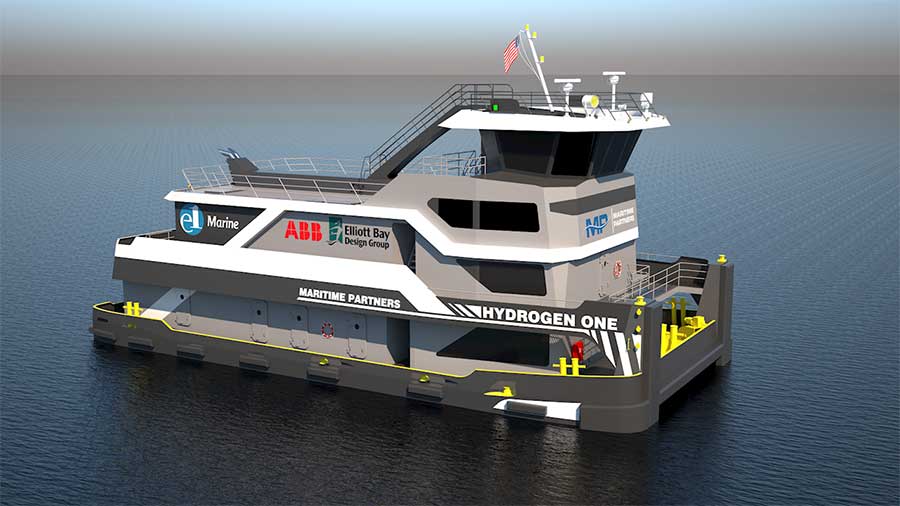Stevie Knight reports on a new towboat developed for American Commercial Barge Line’s Houston-New Orleans route, which uses a water and methanol feedstock mix to produce ‘hydrogen on demand’ onboard
The launch of a methanol-to-hydrogen towboat developed by e1 Marine and Elliott Bay Design Group promises to turn a few heads – and assumptions. Unlike many prototypes, Hydrogen One isn’t starting service on an easy win: rather the reverse. Typically, towboats handle protracted power demands over exhausting distances: in the US, they are a common sight on the waterways that link Houston to New Orleans – a five day run, e1 MD Rob Schluter tells Ship & Boat International.
However, the barges’ clients are asking operators to clean up their act. Unfortunately, currently available low-emission, low-carbon fuels come with issues. “[Alternative fuels] require a larger footprint than the technology they’re replacing,” says Schluter. Some require extra room for pressurised or cryogenic tanks, and energy storage eats into the weight budget. These factors can clash with the required shallow draught: sections of the intercoastal waterway have a depth of only 2.7m. Moreover, there’s little chance of frequent bunkering/recharging stops with few suitable quayside facilities, and the routes tend to be long and variable.
There is a solution: run the propulsion from hydrogen and use methanol as a carrier. Methanol is readily available, as this waterway doubles as the US’ ‘chemical corridor’. This approach produces hydrogen at the point of consumption, eliminating the logistical challenges and costs of storing and transporting compressed hydrogen.
Aboard Hydrogen One, 10 PowerCell fuel cells generate around 1,400kW that goes straight into the onboard DC grid. What isn’t immediately used by the twin Steerprop L-drives or onboard systems gets stored by a 1MW battery. The additional battery boost allows the boat to reach upward of a 1,490kW capability for about a quarter of every 24-hour cycle. However, while these fuel cells provide the power, they rely on 10 of e1’s M-Series M18 hydrogen generators to create on-demand hydrogen from methanol and de-ionised water.
Firstly, the water and methanol feedstock mix passes through a heat exchanger: this preheats the feedstock, helping raise the efficiency of the next stage. The reactor ‘hot box’ comes next: the resulting vapour then meets a catalytic reactor which converts it into syngas, a mixture of hydrogen, carbon monoxide and carbon dioxide. The last step is separating out the hydrogen, purifying and cooling it (see Ship & Boat International January/February 2022, pages 31-33, for an in-depth look at this process).
Hydrogen One will be capable of a five-day range at 5.2knots, with a top transit speed of 8.7knots and a pushing speed of up to 6knots. All this has been achieved inside a 28m x 13.1m hull with a draught of 3.35m. Schluter admits that the boat’s architecture was a challenge: “You’re looking at approximately 6.1m of additional length and another 2.4m in additional beam”, he says, though he adds: “Because Hydrogen One is the first vessel, I guarantee that everything is oversized: in the early days, nobody wants to be caught short.” He adds that the overall size will probably be reduced by 25%.






